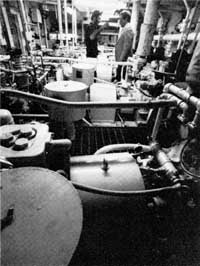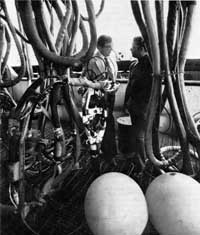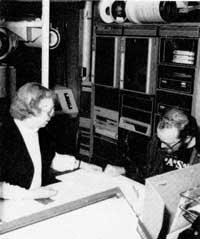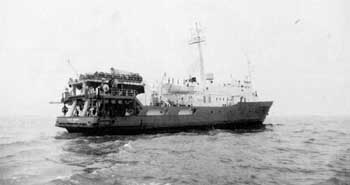
HEDBERG RULES!
Gulf Science and Technology Company
Gulf Oilmanac 6-80, pp. 2-4
In the wake of two highly successful surveys offshore the U.S. West Coast and Venezuela, the R/V Hollis Hedberg, Gulf Science & Technology Company's geophysical exploration-research vessel, currently is working the Gulf of Mexico. The vessel is midway through its sixth year of service as a frontrunner in the energy industry's fleet of high technology ships.
The vessel was named to honor one of Gulf's most distinguished scientists, Dr. Hollis D. Hedberg, retired Vice President of Exploration, who still serves Gulf as an advisor. After her launching in 1974 at Vancouver, British Columbia, the Hedberg first operated in Alaskan waters and later along the lower U.S. Pacific Coast. By early 1977, the ship was in the Gulf, looking at high-priced federal leases for Gulf Oil Exploration & Production Company. In all, the ship has surveyed some 75,000 miles since it was launched.
The vessel has many unique capabilities. Perhaps it is best known for its ability to process the voluminous data from its seismic surveys "in real time" onboard the vessel. It can thus do immediately work which usually takes from two to six months at a computer center onshore after completion of the survey at sea - giving Gulf a big edge in the highly competitive offshore exploration game.
The seismic results are backed up by another Gulf innovation - geochemical seep detection. Scientists and engineers at the Harmarville Research Center have developed equipment to locate and measure the small traces of hydrocarbons which "leak" into the ocean from accumulations deep within the earth. These readings are made at the same time as the seismic surveys.
The latest chapter in the Hedberg story began in mid - 1978 when the vessel was required to expand its role to include not only frontier research and development but state-of-the-art marine seismic technology for Gulf's offshore operations.
Today, after a three-month refit in early 1979, the vessel is arguably the most sophisticated of the industry's fleet. According to A. C. Armstrong, Manager of the Geophysical Applications Department at GS&T's Houston Technical Services Center, the major change was the replacement of the seismic-energy source. Eight air guns, pressurized at 4,500 pounds per square inch, now provide the impulse and are microcomputer-fired in unison. These replace the "sleeve exploders" formerly used, and are an improved version of the industry's "standard" source. The back deck was modified to house the new guns and new compressors were installed below deck in a revamped fuel tank.
During the same period the computer system was extensively upgraded and a long-term goal has been realized: the Hedberg can now produce results at the end of each cruise which are the equivalent in quality to results from an onshore computer center - results which normally are delayed from two to four months.
The payoff from all this shows in the improved quality of seismic records, according to Bob Lattimore and Waldo Gullickson, Hedberg Marine Operations Supervisors. "The more powerful air guns give greater subsurface penetration and better seismic record resolution, so we see more detail," Mr. Lattimore explained.
"Competitively, we now have a state-of-the-art system." Another MOS who sailed the ship before and after the refit, Dave Moore, stressed, "Before, we were providing the same kind of data, but its display quality was poor. We had to send data to HTSC for final stage processing to get the quality expected by Gulf interpreters. This meant delays. With our updated computers and new display hardware, we can give Gulf clients the final results as soon as the vessel 'hits the dock.'"
Following the refit, Mr. Armstrong had won an okay to test the vessel's competitiveness by means of some non-Gulf contract work. Early last year, the ship began a contract survey for the Venezuelan national oil company. This was followed by a group survey along the California coast for 13 U.S. oil companies.
Mr. Lattimore said, "When an oil company hires a crew, they don't expect interpretation - just raw unprocessed data. They usually wait up to six months for the processing and only then begin interpretation. The Venezuelans were immensely impressed when we gave them not only seismic sections marked for evaluation but maps suitable for choosing wildcat locations each time the vessel returned to port. It was most satisfying to hear later that an oil discovery had been made as a direct result of our survey."
Added Mr. Armstrong: "Nobody else even tries to do this much onboard a ship. One payoff is that the Hedberg can acquire and process data up to a few days before an offshore lease sale. Before one recent Gulf of Mexico sale, we worked so close to the cutoff date that our New Orleans Exploration people sent a launch out to the vessel to pick up data for last-minute interpretation."
Producing such results keeps the Hedberg at sea for 18 - day tours with 3 days in port. Usually 10 GS&T geophysicists and technicians make up a tour's team, led by one of three MOS's. Many female employees, both professionals and technicians, have participated in the operation. The ship's crew, all employed by Cayman Islands Vessels, Ltd., from which Gulf charters the vessel, adds about 19 more, and there are some 17 Western Geophysical geophysicists, engineers, and technicians as well who operate the recording equipment and maintain related apparatus. All-important are two contract navigators: a dual system using satellites and shore-based electronic transmissions continuously pinpoints the vessel's location to within a few meters.
Comfortably fitted, the 202-foot Hedberg can work as long as 60 days and cruise up to 7,800 miles without refueling. Top speed is 14 knots under twin, 1,950 hp engines. Four decks include the wheelhouse, radio room, and interpretation office on upper levels, with the main and lower aft decks devoted to the processing center crammed with computers and related printout and storage units, plus recording, reproduction, and drafting apparatus. The three-level rear deck carries the large seismic cable reel as well as the smaller geochemical and magnetometer cables. Racks for the newly installed air gun system occupy the lower rear deck. Living quarters for 49 are inter-spaced throughout the three top decks.
Among GS&T scientists, Hedberg duty has proven an appealing and prestigious assignment - the chance to do one's professional thing aboard a yacht-like vessel and get a terrific tan in the bargain. Pressures to keep up with the demanding 24-hour-a-day schedule spark tension sometimes; yet there's a waiting list for duty assignments. Because the operation covers all aspects of exploration geophysics, it is producing a unique cadre of highly trained professionals and technicians for Gulf.
The Hedberg and its operatives are part of a GS&T marine exploration system started during the mid 1960s when Dr. Hedberg recognized the world's continental margins as a crucially important frontier for potential oil and gas production, and convinced Gulf executives to support a long-range program of marine research and exploration. He wanted an exploration approach that could quickly and efficiently locate the most prospective few square miles within choice basins. The fact that only one percent of world oil fields contains 75 percent of the hydrocarbons supported his thesis of powerful hydrocarbon concentration processes. To permit the overall exploration system, the marine survey vessel he envisioned required complete onboard data processing hardware for an onboard evaluation. Two research vessels were born of this marine search concept: first, the R/V Gulfrex that operated from 1967 to 1975, and the current Hedberg.
"The geophysical element in the exploration process is among the world's fastest evolving and expanding technologies," said Mr. Armstrong. "We depend on the computer industry's new things to do our new things and two or three years is a long time in that business." He notes that further upgrading aboard the Hedberg is probably needed. "We would like to improve the seismic cable and instruments to keep up with the trend to finer and finer sampling of the information from the subsurface. This will enable us to unravel complexities currently beyond our reach."




